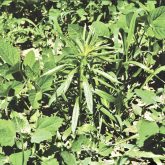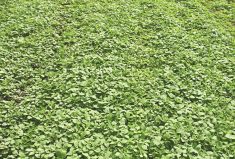Are there any herbicides that I could use to control garlic mustard on the farm?
Garlic mustard is an early flowering weed that’s highly visible at the edge of farm woodlots and around buildings and grain bins in the spring. Although garlic mustard is rarely found competing in agricultural crops, it can invade forests and displace native wildflowers including trillium.
Promising research by Dr. Stephen Murphy (University of Waterloo) demonstrated that planting fast-growing, shade-tolerant native plants like bloodroot at nine to 11 plants/m2 greatly reduced garlic mustard. This would be a preferable long-term approach to reducing garlic mustard in farm woodlots.

However, preventing its spread into woodlots from perimeter areas can be challenging. Competitive plants like bloodroot aren’t easily established, and manual removal of the mustard is not always practical due to the sheer volume of plants. Ideally, a farmer could choose a field crop herbicide, mix a small amount and spot apply.
Unfortunately, very little information on garlic mustard’s sensitivity to herbicides exists. In the spring of 2016, I evaluated five common field crop herbicides to see if they controlled garlic mustard while leaving desirable vegetation (e.g. native grasses).
Making a spray bottle solution: Take a two-litre pop bottle and calculate the amount of herbicide needed for a 1.5-litre spray solution. A syringe is great for measuring small amounts of herbicide and adjuvant (Figure 1 at top of page).
Read Also

Agronomists share tips for evaluating new crop products and tech: Pt. 3
With new products, new production practices and new technology converging on the agriculture industry at a frenetic pace in recent…
Example: Eragon LQ is applied pre-plant to winter wheat at 145 ml/ha with Merge at 1,000 ml/ha and at a water volume of between 100 to 200 l/ha. Here’s how to make up your 1.5-litre spray bottle batch.
First, figure out how many pop bottles it would take to cover one hectare, i.e. 200 litre ÷ 1.5 litre = 133 bottles.
Second, calculate how much Eragon LQ should be added to the bottle, i.e. 145 ml/ha ÷ 133 = 1.09 ml Eragon LG.
Finally, calculate how much Merge to add, i.e. 1,000 ml/ha ÷ 133 = 7.5 ml Merge.
Thus, prepare your 1.5-litre spray bottle with 1.09 ml of Eragon LQ and 7.5 ml of Merge.
Test results: Of the five herbicides applied prior to flowering, glyphosate and Eragon LQ (Figure 3 below) were best at controlling garlic mustard. Unfortunately, glyphosate also controlled other surrounding vegetation, resulting in Canada thistle emerging from shoots and taking over. Native grasses thrived in areas where Eragon LQ was applied. Pixxaro and 2,4-D reduced flowering and seed production while Callisto bleached leaf tissue but did not reduce flowering or seed production.

Have a question you want answered? Hashtag #PestPatrol on Twitter to @cowbrough or email Mike at [email protected].















